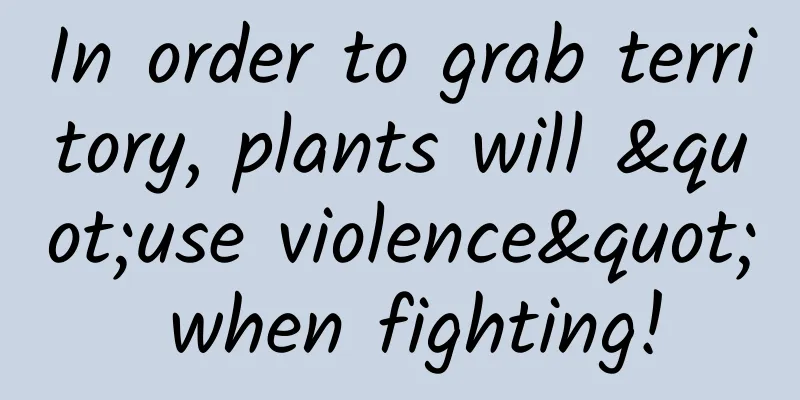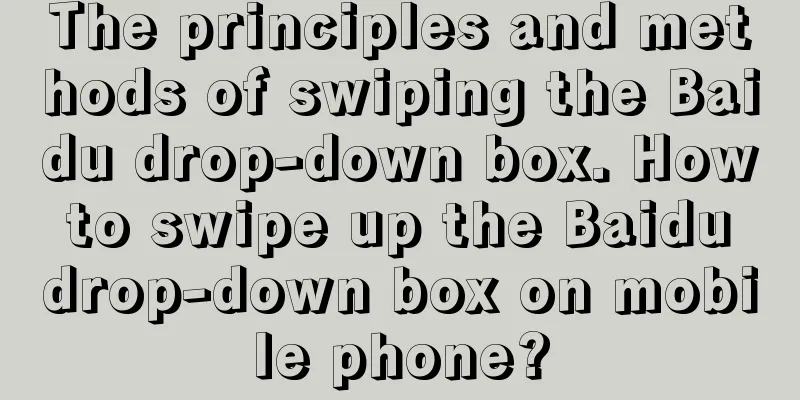In order to grab territory, plants will "use violence" when fighting!

|
Produced by: Science Popularization China Author: Liao Xinfeng (Kunming Institute of Botany, Chinese Academy of Sciences) Producer: China Science Expo The secret struggle between plants After reading the title, you may ask, how do plants do it? In fact, if you extend the time scale a little bit, you will find that the active fighting spirit shown by plants is no less than that of animals: in order to get sunlight and occupy space, they carefully arrange and shade other plants until all the available space is filled. It can be said that every branch and leaf of a plant is "scheming". Their branches can occupy blank areas in the general direction and prevent themselves from being shaded by reasonable layout, while the leaves can also move in a small range and achieve the maximum degree of light orientation by twisting the petiole. The evergreen vine moves its leaves by twisting its petiole (Image source: author) You may have seen this phenomenon in the forest canopy: there are gaps between trees, as if they are showing "kindness" to each other, but this phenomenon, called canopy shyness, is probably not a sign of courtesy between trees, but more likely a sign of struggle. After the branches of several trees invade each other's space, although they do not directly "fight", the wind between the canopies will make them "fight hand to hand". In this way, after long-term physical wear and tear, this tacit gap is left between the canopies, leaving sunlight for the plants at the bottom. Crown shyness (Image source: Wikipedia) Underground, the roots of plants act like animals searching for food, showing their foraging nature. They fight silently to seize the water and nutrients underground, and almost refuse to give up an inch of the soil. The roots, like the above-ground parts of the plants, quietly expand and occupy the empty areas underground in advance. The secret fighting of the roots also causes the plants to differentiate, and the roots in the underground space also appear in layers like the above-ground parts, as if they are giving way to each other, but in fact it is also the result of struggle. Underground root structure (Image source: The Turfgrass Group) Plants even have advance "layouts" on the ground. They "poison" the ground through fallen leaves, and the chemicals produced by the decomposition of these leaves can inhibit the germination of other plants. For example, you may see sparse vegetation under walnut forests. This is because walnuts release walnut phenol from their leaves to the ground to prevent other plants from competing with them for resources. This strategy is called allelopathic effect. Allelopathic effects lead to no plants growing under the forest (Image source: Wikipedia) These common ways of fighting show that plants have been secretly fighting each other for territory and resources, but they have not yet fought directly like animals, because plants are less mobile and it is not convenient to fight. However, the latest research has found that plants can directly "fight" through changes brought about by continuous growth. The “fighting party” among plants For example, the Victoria amazonica that grows in the Amazon is as its name suggests, with a dominant temperament that makes people applaud. In the Amazon, when the Victoria amazonica is about to emerge from the river surface, the river surface may have been filled with other aquatic plants. For those plants that adapt to the water surface habitat, the water surface is an excellent place, with plenty of sunlight and freedom to move. Therefore, when the growing season comes, the plants are bustling and the competition on the water surface is as fierce as that on the African grassland. Unfortunately, the advantage of these floating plants is only temporary. The Victoria amazonica has already been gathering strength before its leaves emerge from the water. As submerged plants, they have roots in the soil to stabilize their bodies. When their leaves are lifted out of the water by their petioles, the Victoria amazonica is already ready to fight. Amazonian water lily leaves emerge from the water (Image source: NikonClub Singapore) When underwater, the leaf buds of the Victoria amazonica have already differentiated. Although they are still buds when they reach the surface, they grow very fast and can expand rapidly. As the leaves continue to grow, they continue to stretch out to the surroundings. The thorns on the back of the Victoria amazonica leaves can crush the surrounding plants as they grow and stretch. Victoria amazonica uses the thorns on the back of its leaves to crush other plants (Image source: Wordpress) If time-lapse photography is used to show the growth process of Victoria amazonica, the whole set of operations of its leaves can emerge in full view. It turns out that when the leaves are not unfolded, the thorns on the back of the leaves will extend and curl up to protect the buds. As the leaves grew and expanded, they began to swirl on the surface of the river, using the roots at the bottom of the river as the fulcrum and the petiole as the radius, circling like a lasso. Other plants were powerless to resist, and the thorns on the leaves were able to sweep the surface of the lake, invincible, and as domineering as the lion king on the African grasslands. Amazonian water lily leaves use sweeping and crushing to finally dominate the water surface (Image source: rove.me) The "scheming" plant that "lies down" first and then takes action The Victoria amazonica uses the power of growth to take the initiative to fight with other aquatic plants on the river surface. Coincidentally, a small grass of the Asteraceae family living in the Savannah grassland environment, Elephantopus elatus, also uses the same strategy to fight on the ground. They look like they are completely "lying flat": the leaves are mainly on the ground, spread out in a rosette shape, and have no intention of emerging. The only time they emerge is during the breeding season, when the flowers will emerge from the ground to facilitate pollination and seed dispersal. The rest of the time, the leaves are completely "lying flat" and only expand horizontally. The lying posture of the ground dandelion (Image source: phytoimages.siu) In this growth pattern, they are quickly shaded by rapidly emerging grasses. Interestingly, their rosette-shaped leaves are not competitive in the vertical direction of the ground, but they can "move forward". When their leaves grow, the edges of the leaves curl inward, like a tray turned upside down on the ground, to gain grip, so that when the leaves extend rapidly, they can push away the grass seedlings that emerge nearby and prevent their area from being shaded. In this way, the scattered surface leaves can grab territory on the surface. Researchers transplanted spathodea from the wild habitat for experiments, and inserted a plastic tube in the direction of their leaf growth, on which a miniature force measuring instrument was installed. The study found that by crawling on the ground, spathodea used the tip of its leaves to push forward continuously, and the leaves could push out an average force of 0.018N, and the maximum force could reach 0.2N. The range of thrust generated by the leaves of the spathiphyllum (Image source: References, Chinese translation: Zhu Huan) Although these efforts may seem insignificant, they are not like ants trying to shake a tree. They are not facing a giant, but a young grass seedling that has just emerged. What they have to do is to strangle the seedling in the cradle to prevent it from growing and shading itself. Measurement of thrust and distance generated by ground dandelion (Image source: References) In addition to measuring force, the researchers also placed ryegrass (Lolium perenne) seedlings around the groundhog. They found that the force generated by the groundhog was enough to push or even cover 20 ryegrass seedlings. This is not only the effect of the force of the grasshopper, but also the pressure from its body shape. Facing the unstretched grass seedlings, the grasshopper's leaves appear very wide, just like using a bulldozer to push a pile of grass, which does not require much effort. If the first push is not successful, the grasshopper will send out the second and third waves of leaves from the same base point, with a sense of heroism that it will not give up until it achieves its goal. The groundgrass pushes the ryegrass growing around it (Image source: References) For the ground dandelion living in seasonal grasslands, its active competitive strategy is targeted and effective. When the growing season of grasses comes, these grasses will quickly grow taller from underground sprouts. Before long, these tall grasses can shade the ground dandelion, making it a real bottom layer without sunlight. Fully grown grass in Savannah (Image source: Pinterest) But through the rapid growth of leaves, researchers estimate that a plant can maintain its own 0.1 square meters of area, which will not be shaded by the thrust and body pressure. In this way, even if the plant is still on the surface, but the upper layer is not occupied, it will be the top layer and enjoy sufficient sunlight. The leaves of the spathiphyllum grow rapidly, generating thrust (Image source: References) Conclusion This discovery has opened up a new chapter in the study of the active struggle of plants. There are many plants with rosette-shaped leaves around us. They seem to be staying quietly on the surface, but perhaps they have actually been working hard in secret. Let's imagine that when we see a forest, what we see may just be the result of the struggle between plants. The vertical structure of the forest is often very obvious, with trees at the top, shrubs next, herbs at the bottom, and vines climbing in between, but if we think about the process carefully, the process of each plant occupying its own position may also be very exciting and intense. Perhaps, there will be more active "action" events waiting for us to discover in the future. References: [1]Sicangco, Camille K., et al. "Active space garnering by leaves of a rosette plant." Current Biology 32.8 (2022): R352-R353. |
<<: Long picture | How beautiful is love? See the love code of a scientist couple
>>: The mustard you eat may be fake! 1 trick to help you choose the right one →
Recommend
5 basic steps for online operation and promotion!
Whether it is online operation and promotion or o...
Top 10 new features in Android M that Google didn't mention
Google officially launched Android M and its new ...
25 Marketing Operation Experiences That Will Keep Opening Your Mind (Part 2)
There is no standardized perfect solution for mar...
"Cliff-like aging" really exists! Scientists reveal two key time points for accelerated aging of the human body
Tuchong Creative Such plots often appear in movie...
Is it really dangerous to exercise after staying up late?
Fitness is undoubtedly a good habit. Drink a cup ...
I sent out 60,000 red envelopes, and what did I get?
1 I checked the red envelope records today and fo...
Google finally compromises, native app store takes back Chinese market
[[147857]] On September 5, according to The Infor...
Gentle White is Not White · Douyin 0-cost project: single-day income of 500, no work release, no account maintenance [video course]
Gentle White is Not White · Douyin 0-cost project...
How much does it cost for a Shantou merchant to create an appointment registration app?
According to industry insiders, mini programs wil...
From the Olympics to daily fitness: Do you get the complete guide to first aid for sports injuries?
The Paris Olympics is halfway through. While watc...
When Foxconn positioned Sharp in the low-end market, the sales of tens of millions turned out to be a poison to quench thirst
After committing itself to Foxconn, Sharp seemed ...
Xiaomi App Store CPD Price and Resources Introduction
1. Service Introduction Xiaomi App Store is the f...
A stock trading experience that will always be remembered
Every amateur investor and speculator will have m...
Xiaohongshu promotion: Xiaohongshu mini program product analysis!
The development of mini programs provides support...
Can't tell the difference between spring, summer, autumn and winter? Cold wave, sandstorm and gale warnings issued in succession, with local temperature dropping by more than 20℃
From today (25th) to the 30th, a cold wave will a...









